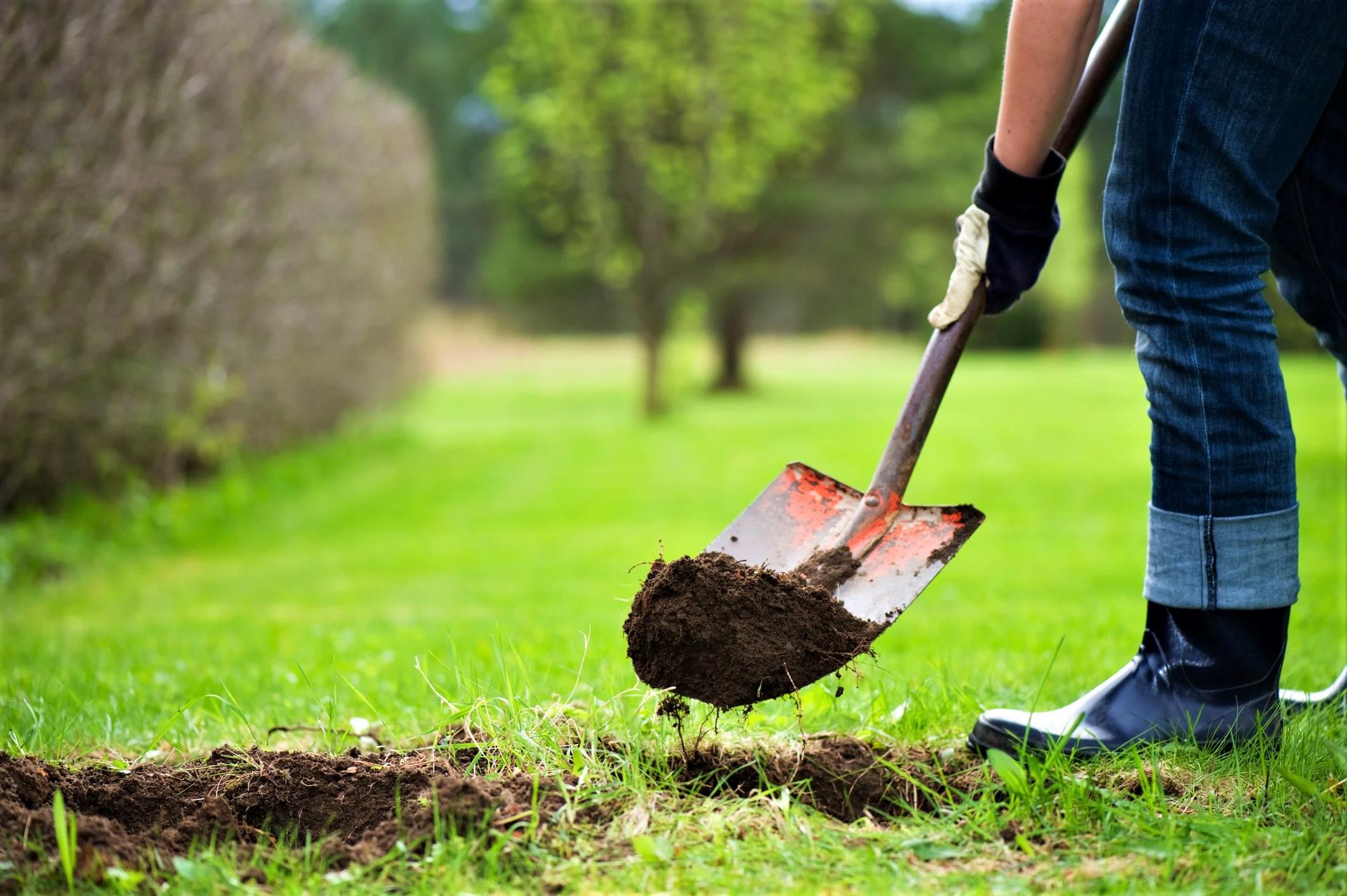Home>Garden Design>How Deep Can I Dig In My Backyard


Garden Design
How Deep Can I Dig In My Backyard
Modified: February 6, 2024
Discover how deep you can dig in your backyard for planning your garden. Uncover essential tips and guidelines to maximize your gardening space and create a flourishing oasis.
(Many of the links in this article redirect to a specific reviewed product. Your purchase of these products through affiliate links helps to generate commission for Chicagolandgardening.com, at no extra cost. Learn more)
Table of Contents
Introduction
When it comes to planning your garden, one important aspect to consider is how deep you can dig in your backyard. The depth of your digging will determine the types of plants you can grow, the structures you can install, and the overall landscape design you can create.
Digging in your backyard may seem like a straightforward task, but there are several factors you need to consider before you start excavating. Local regulations and permits, soil composition, the presence of underground utilities, and even potential environmental impacts are all important considerations that can impact the depth of your digging.
Understanding the limitations and requirements of digging in your backyard will not only help you plan your garden effectively but also ensure that you adhere to any legal requirements and maintain the safety of yourself and your property.
In this article, we will explore the various factors you need to consider when determining how deep you can dig in your backyard. We will discuss the importance of local regulations and permits, the influence of soil composition, the potential dangers of underground utilities, the environmental impacts of digging, the tools and equipment you may require, and the necessary safety precautions. By the end, you will have a comprehensive understanding of the factors that determine the depth of your digging and be better prepared to plan your garden accordingly.
Factors to Consider
Before you begin digging in your backyard, there are several important factors that you need to take into account. These factors can influence the depth to which you can dig and impact your garden planning process. Let’s explore these factors in detail:
Local Regulations and Permits: It is essential to check with your local municipality or homeowners association regarding any regulations or permits required for digging in your backyard. Some areas may have restrictions on the depth of digging or specific guidelines for certain types of projects. By understanding and complying with these regulations, you can avoid legal issues and ensure a smooth gardening process.
Soil Composition and Type: The composition and type of soil in your backyard can influence the depth to which you can dig. Clay soil, for example, tends to be denser and harder to dig, requiring more effort and specialized tools. Sandy soil, on the other hand, is looser and easier to excavate. Conduct a soil test to determine its composition and consider how it may affect your digging plans.
Depth of Underground Utilities: Before digging, it’s crucial to know the location and depth of any underground utilities, such as gas lines, water pipes, or electrical cables. Accidentally hitting these utilities can be dangerous and costly. Call the relevant utility companies to mark the locations of these lines to ensure safe digging and prevent any damages.
Environmental Impacts: Consider the potential environmental impacts of your digging activities. Underground water sources, tree roots, or sensitive ecosystems may be present in your backyard. Disturbing these can have adverse effects on the environment. Taking environmental considerations into account will help you minimize any negative impacts and maintain a sustainable garden.
By carefully considering these factors, you can determine the maximum depth to which you can dig in your backyard. This knowledge will inform your garden planning process, ensuring that you create a beautiful and functional outdoor space while adhering to all necessary regulations and safeguards.
Local Regulations and Permits
Before you grab your shovel and start digging in your backyard, it is crucial to familiarize yourself with the local regulations and obtain any necessary permits. Local regulations and permits vary depending on where you live, and failing to comply with them can result in legal consequences and potential fines. Understanding and adhering to these regulations will ensure a smooth and hassle-free gardening experience.
Contact your local municipality or homeowners association to inquire about any specific regulations related to digging in your area. Some municipalities may have restrictions on the depth to which you can dig, especially if you live in an area with underground utilities or protected environmental zones. They may also have guidelines or restrictions for certain types of projects, such as installing structures or digging for drainage purposes.
In some cases, you may need to obtain a permit before you can start your digging project. This is particularly common for larger-scale excavation or construction projects. The permit process usually involves submitting an application, which outlines the details of your project, such as the depth of digging, the area to be excavated, and the purpose of the project. It is essential to provide accurate and thorough information to ensure a smooth permit approval process.
Obtaining permits may require paying a fee, and there may be additional requirements, such as submitting plans or having the project reviewed by a professional. Familiarize yourself with the specific requirements and timelines for permit applications in your area.
Complying with local regulations and obtaining the necessary permits is not only important for legal reasons, but it also ensures the safety of your property and the surrounding environment. Understanding the rules and requirements will help you plan your garden effectively and mitigate any potential risks associated with digging.
Remember, local regulations and permit requirements may change over time, so always stay up-to-date with any new guidelines or updates. Consulting with local officials or experts in your area can provide you with accurate and current information, ensuring that you stay in compliance and enjoy your garden without any unnecessary complications.
Soil Composition and Type
The composition and type of soil in your backyard play a crucial role in determining the depth to which you can dig. Understanding the characteristics of your soil will help you plan your garden effectively and determine the appropriate depth for your digging projects.
The first step in assessing your soil composition is to conduct a soil test. Soil tests are readily available at gardening centers or through professional soil testing services. These tests analyze the composition of your soil, including its texture, nutrient content, and pH levels.
One key factor to consider is the texture of your soil. Soils are commonly categorized as clay, silt, or sand. Clay soil, which is fine and compact, tends to be more challenging to dig than looser soil types. Sandy soil, on the other hand, is lighter and easier to excavate. The composition of your soil will affect the effort, tools, and equipment required for digging.
In addition to texture, the nutrient content of your soil is also essential for plant growth. A soil test will provide information about the organic matter, nitrogen, phosphorus, and potassium levels in the soil. This information will help you determine the necessary steps to improve the soil fertility and create an optimal environment for your plants.
The pH level of your soil is another critical factor to consider. pH measures the acidity or alkalinity of the soil. Different plants thrive in different pH ranges, so understanding your soil’s pH will guide your plant selection and determine the depth to which you can dig. Some plants require specific pH levels, and attempting to dig too deep may result in soil imbalance, affecting plant health and growth.
It’s important to note that soil composition can vary within a single backyard. Certain areas may have pockets of different soil types, so it’s advisable to conduct multiple soil tests in different locations to gather a comprehensive understanding of your soil composition.
By understanding the composition and type of your soil, you can tailor your gardening plans accordingly. This includes selecting appropriate plants, determining the depth for planting and excavating, and making informed decisions about soil amendments and fertilizers. Working with the natural characteristics of your soil will result in healthier plants and a thriving garden.
Depth of Underground Utilities
Before you embark on any digging project in your backyard, it is essential to be aware of the depth of underground utilities. Hitting an underground utility line can not only be dangerous but also result in costly damages and potential disruptions to essential services. Taking the time to locate and understand the depth of these utilities will ensure safe and successful excavation.
To determine the presence and depth of underground utilities, it is advisable to contact your local utility companies. They have resources and expertise to accurately mark the location of utility lines, such as gas, water, sewer, and electrical cables. Many utility companies offer free or low-cost services to help homeowners identify and avoid damaging these lines.
Utility companies use various methods to identify the location and depth of their lines. These may include physical markers, such as flags or paint markings, or using specialized equipment that detects buried utilities. It’s important to follow the guidelines provided by the utility companies to ensure accurate location and safe digging practices.
Different utilities have varying depths at which they are buried. For example, water lines are typically buried at a depth of 18 to 36 inches, while gas lines are often deeper, ranging from 24 to 36 inches. Electrical cables are usually found deeper still, at depths of 36 to 48 inches or more. These depths ensure that the utility lines are protected and less susceptible to accidental damage.
Keep in mind that the depth of utilities can vary depending on local regulations, terrain conditions, and the specific utility company. It’s crucial to consult with the utility companies in your area to obtain accurate information about the depth of underground utilities.
When planning your digging projects, it is important to maintain a safe distance from the marked utility lines. Respect the indicated margins to prevent accidental damage or disruptions. Use hand tools, such as a shovel or hand trowel, when approaching the area close to the marked utilities to reduce the risk of damaging the lines.
If you suspect that the utility lines are located deeper than you intend to dig, it is recommended to consult with a professional excavation contractor or utility company. They can assess the situation and provide guidance on how to proceed safely.
By considering the depth of underground utilities and taking necessary precautions, you can ensure the safety of your digging projects and avoid any costly and potentially dangerous mishaps. It’s always better to be proactive and informed when it comes to working around underground utilities in your backyard.
Environmental Impacts
When planning to dig in your backyard, it’s important to consider the potential environmental impacts of your excavation activities. Digging can disturb the natural ecosystem and impact underground water sources, tree roots, and other sensitive elements in your yard. By understanding and mitigating these impacts, you can maintain a sustainable garden and minimize any negative consequences.
One vital aspect to consider is the presence of underground water sources, such as wells, aquifers, or water tables. Disturbing these water sources can lead to contamination or depletion, affecting not only your own access to water but also neighboring properties. Carefully assess the depth and location of any water sources before digging to avoid any potential contamination or interference.
Tree roots are another important consideration. They help stabilize the soil, provide nutrients, and contribute to the overall health of the ecosystem. Digging too deep or too close to tree roots can damage or weaken the trees, leading to their decline or even death. It’s crucial to identify the location of tree roots and avoid disturbing them during excavation. Consulting with an arborist or tree care professional can provide guidance on how to work around tree roots effectively.
The overall ecosystem and biodiversity of your backyard should also be taken into account. Your garden may be home to various plants, insects, animals, and microorganisms that contribute to a balanced ecosystem. Consider the potential impacts of digging on these organisms and minimize disruption as much as possible. For example, setting aside areas untouched by digging can provide refuge for wildlife and support the natural balance of your garden.
Soil erosion is another potential issue that can result from improper digging practices. Excavating too deeply or without proper soil stabilization measures can lead to soil erosion, which compromises the stability of your garden and can cause downstream sedimentation issues. Implementing erosion control techniques, such as retaining walls, terracing, or adding vegetation, can help prevent erosion and maintain the integrity of your soil.
When planning your digging projects, consider incorporating sustainable practices that minimize environmental impacts. This may include avoiding excessive excavation, using organic and environmentally friendly materials, and implementing water conservation measures. By being mindful of the environmental consequences of your digging activities, you can create a garden that supports the health of both your backyard and the wider ecosystem.
If you are unsure about the potential environmental impacts of your digging plans, consider consulting with a professional landscaper, environmental specialist, or conservation agency. They can provide expert advice and guidance to help you make environmentally responsible decisions and ensure the long-term sustainability of your garden.
Tools and Equipment Required
When it comes to digging in your backyard, having the right tools and equipment is essential for a successful and efficient project. The tools you need will depend on the depth and scale of your digging, as well as the type of soil and the purpose of the excavation. Here are some common tools and equipment that you may require:
Shovel: A sturdy shovel is a must-have tool for any digging project. It is versatile and can be used for various tasks, such as breaking up soil, removing debris, and digging trenches. Look for a shovel with a comfortable grip and a durable blade that can withstand the demands of your digging project.
Hand Trowel: A hand trowel is a smaller, handheld digging tool that is useful for precise digging, planting, and working in tight spaces. It is ideal for tasks such as removing weeds, digging small holes for plants, or leveling the soil in your garden beds.
Spade: A spade is similar to a shovel but has a narrower and flatter blade. It is beneficial for cutting through roots, edging garden beds, and making clean, straight-sided trenches or holes. Consider a spade with a comfortable handle and a sharp, durable blade for efficient digging.
Digging Fork: A digging fork is designed to loosen and aerate compacted soil. It has sturdy tines that can penetrate the soil easily and help break up clumps. A digging fork is especially useful for digging in heavier soils, such as clay, and preparing the ground for planting.
Post Hole Digger: If you need to dig deep holes, such as for fence posts or large plants, a post hole digger can be a valuable tool. It consists of two long handles connected to two sharp blades that dig into the ground, allowing you to remove soil and create precise holes efficiently.
Trenching Shovel: For projects that require digging long, narrow trenches, a trenching shovel is the tool of choice. It has a long, thin blade that can cut through the soil and create trenches of consistent width and depth. This type of shovel is commonly used for installing irrigation systems or laying underground cables.
In addition to these digging tools, you may also need other equipment depending on the nature of your project. This can include wheelbarrows or garden carts for transporting soil or debris, a hand compactor for compacting soil, and a soil testing kit for assessing soil composition.
Before starting your digging project, assess the tools and equipment you have and determine if additional items are needed. Consider the quality and durability of your tools to ensure they can handle the demands of your digging projects. Investing in higher-quality tools can save you time, effort, and frustration in the long run.
It’s also essential to prioritize safety when using tools and equipment. Always wear appropriate protective gear, such as gloves and safety glasses, and follow proper techniques to avoid injury. Consult user manuals or seek guidance from professionals if you are unsure about how to use a particular tool.
By having the right tools and equipment and using them safely and effectively, you can ensure a smooth and successful digging project in your backyard.
Safety Precautions
When it comes to any digging project in your backyard, safety should always be a top priority. Excavation work can present various hazards, including potential injuries and damage to property. By following proper safety precautions, you can minimize risks and ensure a safe and successful project. Here are some essential safety precautions to keep in mind when digging in your backyard:
Locate Underground Utilities: Before digging, it is crucial to contact your local utility companies to locate and mark the position of any underground utilities. This will help you avoid accidentally damaging gas lines, water pipes, or electrical cables during your excavation. Digging without this information can lead to serious injuries, service disruptions, and costly repairs.
Wear Protective Gear: Always wear appropriate personal protective equipment (PPE) when digging. This includes sturdy work gloves, steel-toed boots, safety glasses or goggles, and a hard hat. PPE will protect you from potential injuries caused by sharp objects, falling debris, or accidental contact with buried utilities.
Use the Right Tools for the Job: Ensure that you are using the correct tools and equipment for your digging project. Using tools that are designed for the specific task at hand will make the job easier and safer. Avoid using damaged or faulty tools and ensure that you are comfortable and familiar with their proper usage.
Take Care with Power Tools: If using power tools for digging, such as a mini-excavator or a trencher, it is essential to receive proper training and follow manufacturer guidelines. Working with power tools requires an understanding of their safe operation, maintenance, and potential risks. Always adhere to the recommended safety precautions, such as wearing hearing protection and using safety guards.
Digging depth: Be mindful of the depth to which you are digging. Avoid excavating too deep as it can increase the risks of instability, collapses, or encountering underground hazards. Follow the guidelines provided by utility companies and permits, and if in doubt, consult with professionals to ensure safe excavation depths.
Call Before You Dig: Most jurisdictions have a free “Call Before You Dig” service, which allows you to notify utility companies of your excavation plans. This service will ensure that utility companies come and mark the location of underground utilities before you begin digging. It is a critical step in preventing accidental damage and ensuring safety.
Stay Hydrated: Digging can often be physically demanding work, especially in hot weather. Ensure that you stay hydrated by drinking plenty of water throughout the project. Take frequent breaks to rest and avoid overexertion, as fatigue can lead to accidents.
Work with Others: Whenever possible, it is advisable to have someone else present during your digging project. Having a partner can provide assistance in case of emergencies and make the task safer overall. If you are working alone, make sure you inform someone about your plans and establish a check-in system.
By following these safety precautions, you can minimize the risks associated with digging in your backyard. Remember, safety should always be your top priority, ensuring that your project is completed without accidents or incidents.
Methods for Digging
When it comes to digging in your backyard, there are several methods you can use depending on the size and scope of your project. Each method has its own benefits and considerations, and choosing the appropriate method will help you accomplish your digging goals efficiently. Here are some commonly used methods for digging:
Manual Digging: Manual digging is the most basic and straightforward method. It involves using hand tools, such as shovels, spades, or hand trowels, to excavate the soil. This method is suitable for smaller-scale projects, such as planting beds or removing small amounts of soil. Manual digging allows for more control and precision, especially in tight or delicate areas.
Machine-Assisted Digging: For larger or more demanding projects, using machinery or equipment can significantly speed up the digging process. Mini-excavators, backhoes, or trenchers are commonly used to excavate larger areas or dig deeper trenches. It is crucial to receive proper training and follow safety guidelines when operating these machines.
Hand Auger or Post Hole Digger: Hand augers or post hole diggers are specialized tools designed to dig deep, narrow holes. These tools have a spiral-shaped metal blade at the end that screws into the ground as you rotate it. They are commonly used for projects like fence post installation or planting larger plants. Hand augers or post hole diggers provide a more controlled and precise digging experience.
Hydro Excavation: Hydro excavation involves using high-pressure water jets to loosen the soil and a vacuum system to remove the excavated material. This method is particularly useful when digging near sensitive underground utilities or in areas where soil disturbance needs to be minimized. Hydro excavation is non-destructive and reduces the risk of damaging underground infrastructure.
Trenchless Digging: Trenchless digging methods are used when it is necessary to install underground utilities or perform repairs without extensive excavation. Techniques, such as horizontal directional drilling or pipe bursting, allow for minimal disruption to the surface while achieving the desired results. Trenchless methods are often used for installing pipes or cables without the need for traditional trench digging.
Excavation with a Garden Hoe: For smaller and shallower digging tasks, a garden hoe can be a useful tool. It has a flat, wide blade that can easily break up the top layers of soil. A garden hoe is ideal for tasks like weeding, preparing planting beds, or leveling the soil surface.
Before choosing a method for digging, consider the size, depth, and specific requirements of your project. Evaluate the access to the site, the type of soil, and any potential obstacles or hazards that may affect your chosen method. Additionally, take into account your own physical abilities and level of experience when deciding between manual or machine-assisted digging.
Remember to always follow proper safety precautions and use the appropriate tools and equipment for the chosen method. If you are unsure about which method is best suited for your project, consult with a professional or seek advice from experienced gardeners or contractors. Determining the right method for digging will contribute to the success and efficiency of your backyard project.
Tips for Digging Deeper
If you have a project that requires digging deeper in your backyard, whether it’s for installing a pond, building a retaining wall, or creating a basement, there are some important tips to keep in mind. Digging deeper poses its own set of challenges and considerations, but with proper planning and execution, you can achieve your desired results. Here are some tips to help you dig deeper in your backyard:
Plan and Prepare: Before you begin digging, take the time to plan and prepare for the project. Assess the site, identify any potential obstacles or hazards, and determine the depth and dimensions of the excavation. Create a detailed plan, including how you will manage the removed soil and any necessary support structures for deeper holes or trenches.
Check for Underground Utilities: It is absolutely crucial to locate and mark any underground utilities before you start digging. Contact your local utility companies to have them mark the location of gas lines, water pipes, electrical cables, and other utilities. Pay attention to their depth and proximity to your project area to avoid any accidents or damages.
Invest in Quality Tools: When digging deeper, it’s essential to have the right tools that can withstand the demands of the project. Invest in high-quality shovels, picks, or digging bars that are designed to handle heavy-duty tasks. Having sturdy and reliable tools will make the digging process more efficient and ensure your safety.
Use Sloping and Benching Techniques: When digging deeper trenches, especially in loose or unstable soils, consider using sloping or benching techniques. These methods involve creating steps or inclined sides in the excavation to prevent collapse and maintain stability. Sloping the sides of the trench at a safe angle or creating horizontal platforms at regular intervals helps prevent soil from caving in.
Support Excavation Walls: In some cases, especially when digging deeper holes or basements, you may need to support the excavation walls to prevent collapse. Temporary support methods, such as shoring, bracing, or sheet piling, can be used to stabilize the sides of the excavation and ensure a safe working environment. Consult with a professional if you require additional support for deeper excavations.
Manage Soil Removal: Deeper digging projects often generate a significant amount of soil that needs to be removed from the site. Plan for how you will handle the excavated soil, whether you will have it hauled away, repurposed in other areas of your property, or used to create raised beds or berms. Proper soil management is essential to maintain a clean and organized work area.
Take Breaks and Pace Yourself: Digging deeper can be physically demanding work, so it’s important to take regular breaks and pace yourself. Avoid overexertion by listening to your body and not pushing beyond your limits. Staying hydrated and using proper lifting techniques can help prevent fatigue and reduce the risk of injuries.
Consider Professional Help: For extremely deep or complex digging projects, it may be wise to seek the assistance of a professional contractor or excavator. They have the expertise, equipment, and experience to handle more challenging excavations safely and efficiently. Consulting with a professional can ensure that your project is completed to the highest standard and in compliance with local regulations.
By following these tips, you can navigate the challenges of digging deeper in your backyard and achieve the desired results. Remember, safety should always be a priority, and if you encounter any difficulties or uncertainties, don’t hesitate to seek professional guidance. With proper planning, appropriate tools, and careful execution, you can successfully dig deeper and turn your backyard vision into a reality.
Conclusion
Digging in your backyard can be an exciting and fulfilling endeavor as you plan and create your dream garden. However, it is important to approach the digging process with careful consideration for various factors that can influence the depth and scope of your excavation. By understanding local regulations and obtaining necessary permits, assessing soil composition and type, locating underground utilities, and being mindful of environmental impacts, you can ensure a successful project that adheres to safety standards and maintains the integrity of your property and surrounding environment.
Equipping yourself with the appropriate tools and equipment, following safety precautions, and choosing the right methods for digging will contribute to the efficiency and effectiveness of your project. Taking into account specific tips for digging deeper and considering professional assistance when needed further enhance your digging experience.
Remember to consult with local authorities, utility companies, and professionals whenever in doubt or when faced with more complex digging projects. Taking the time to plan, prepare, and execute your digging projects with care will not only result in a beautiful and functional garden but also ensure your safety and compliance with legal requirements.
So go ahead and turn your backyard into a space that reflects your vision and creativity. With proper knowledge and understanding, you can confidently dig to the appropriate depth, create stunning landscape designs, plant a variety of vegetation, or install structures that enhance your outdoor living space. Enjoy the process of planning your garden and the satisfaction of seeing your efforts come to fruition. Happy digging!





